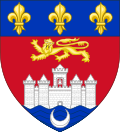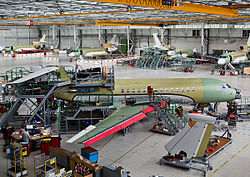Bordeaux
Bordeaux is a city in the Gironde department of France. It is on the Garonne River near the Atlantic Ocean. About 1,150,000 people live in the area around the city. Bordeaux has a temperate oceanic climate (Cfb in the Koeppen climate classification). It is famous for wines made in the region near the city. Bordeaux is also famous for its art.
|
Bordeaux | |
|
Motto: Lilia sola regunt lunam undas castra leonem. | |

| |
| Administration | |
|---|---|
| Country | France |
| Region | Aquitaine |
| Department | Gironde |
| Arrondissement | Bordeaux |
| Canton | 5 cantons |
| Intercommunality | Bordeaux Métropole |
| Mayor | Nicolas Florian (LR) (2019–2020) |
| Statistics | |
| Land area1 | 49.36 km2 (19.06 sq mi) |
| Population2 | 252,040 (2016[2]) |
| - Ranking | 9th in France |
| - Density | 5,106/km2 (13,220/sq mi) |
| Urban area | 1,172.79 km2 (452.82 sq mi) (2010) |
| - Population | 760,933 [3] (January 2011) |
| Metro area | 5,613.41 km2 (2,167.35 sq mi) (2010) |
| - Population | 1,195,335[4] (2013) |
| Website | www |
| Official name | Bordeaux, Port of the Moon |
| Criteria | Cultural: ii, iv |
| Reference | 1256 |
| Inscription | 2007 (31st Session) |
| Area | 1,731 ha |
| Buffer zone | 11,974 ha |
| 1 French Land Register data, which excludes lakes, ponds, glaciers > 1 km² (0.386 sq mi or 247 acres) and river estuaries. | |
| 2 Population without double counting: residents of multiple communes (e.g., students and military personnel) only counted once. | |
Bordeaux is classified as a "City of Art and History". The city is home to 362 monuments historiques. Some buildings date back to Roman times. It is a UNESCO World Heritage Site.[5]
History
| UNESCO World Heritage Site | |
|---|---|
| Criteria | Cultural: ii, iv |
| Reference | 1256 |
| Inscription | 2007 (31st Session) |
In about 300 BC Bordeaux was the settlement of a Celtic tribe. They named the town Burdigala. The Romans began rule of the city around 60 BC. Later it became capital of Roman Aquitaine. In the 400s the city was looted by the Vandals, Visigoths, and Franks.
After the Battle of Poitiers, Duke Eudes was able to hold only a small part of Aquitaine where Bordeaux was located. It became one of the last cities to fall under King Pepin the Short.
Bordeaux once again became an important city after the marriage of Duchess Eléonore of Aquitaine with Count Henri Plantagenet. He became King Henry II of England only months after their marriage.
In 1653 Bordeaux was added to the Kingdom of France, when the army of Louis XIV entered the city.
In 1870 the French government moved to Bordeaux for a time. This was at the beginning of the Franco-Prussian war against Prussia. The temporary move happened again during World War I and again very briefly during the World War II.
Education
- École nationale supérieure d'électronique, informatique, télécommunications, mathématiques et mécanique de Bordeaux
- École pour l'informatique et les nouvelles technologies
- École spéciale de mécanique et électricité
- Institut supérieur européen de gestion group
- E-Artsup
- Institut supérieur européen de formation par l'action
- University of Bordeaux 1
- Kedge Business School
Sister cities
Bordeaux is twinned with:
|
|
Partnerships
|
Bordeaux Media
Coins of the Bituriges Vivisci, 5th–1st century BC, derived from the coin designs of Greeks in pre-Roman Gaul. Cabinet des Médailles.
Merovingian tremisses minted in Bordeaux by the Church of Saint-Étienne, late sixth century. British Museum.
Port of the Moon in 1759
Aerial view of the Port of the Moon in 1899
The Place de la Comédie during the German occupation
Aerial view of the Garonne in Bordeaux in 2019
Saint-Émilion aerial view
The current mayor Pierre Hurmic
References
- ↑ [1][dead link]
- ↑ "Bordeaux en chiffres".
- ↑ Séries historiques des résultats du recensement – Unité urbaine 2010 de Bordeaux (33701), INSEE.Retrieved 2 August 2014
- ↑ "Séries historiques des résultats du recensement – Aire urbaine 2010 de Bordeaux (006)". INSEE. Retrieved 2 August 2014.
- ↑ "Bordeaux, Port of the Moon". UNESCO. Retrieved 7 May 2017.
Other websites
![]() Media related to Bordeaux at Wikimedia Commons
Media related to Bordeaux at Wikimedia Commons![]() Bordeaux travel guide from Wikivoyage
Bordeaux travel guide from Wikivoyage









